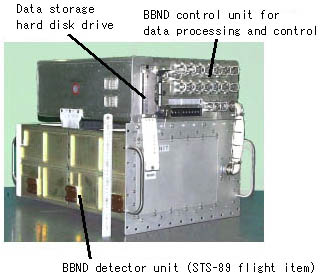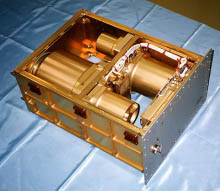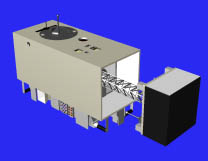|

| Neutron measurement experiment to be conducted in the International
Space Station | |
 |
US Laboratory of the ISS
The US Laboratory,
nicknamed DESTINEY, is scheduled to be launched in January 2001 on mission STS-98
by Space Shuttle Atlantis. |
NASDA(JAXA) will conduct a neutron measurement inside the International
Space Station (ISS) for about eight months using the NASDA(JAXA)-developed
BBND located in the US experiment module of the ISS from February 15,
2001.
 | Purpose
of the Neutron Measurement Experiment |
The Neutron Measurement Experiment will be conducted as a part of the
Human Research Facility (HRF) project of NASA. NASDA(JAXA) will take part
in this HRF project with the BBND. NASDA(JAXA) will offer the obtained
data to the international partners and will utilize the data for enhancing
the space radiation exposure management technology needed for human activity
in the ISS.
 | Human Research
Facility project | The HRF project is a widely ranging international
cooperative project conducted on the ISS to study the effects of the space environment
on the ISS. Experiments on space radiation measurement, nerve medicine, and space
psychology are planned for the HRF project. The HRF project will be conducted
by the US with participation of universities and national research organizations
from Japan and Germany and other countries.
In the space radiation measurement field, neutrons will be measured inside
the ISS using NASDA's(JAXA's) BBND, charged particles will be measured
(DOSMSP) by the aerospace laboratory of Germany (DLR), and human internal
organs radiation will be measured (TORSO) using NASA's human body model
from February 2001 in the US laboratory of the ISS.
 | Outline
of the Bonner Ball Neutron Detector |
NASDA's(JAXA's) BBND was developed by attaching a control unit that processes,
controls and records the data to the neutron detector that was on board
the STS-89. The data will be transmitted to the ground once a week. This
experiment will be continued for as long as eight months to acquire the
neutron energy spectrum inside US module.
What is Neutron?
A neutron is an elementary particle. Since a newtron has no electric charge, it
can penetrate most substances. Even low-energy neutrons can reach the internal
human organs including marrow. It is said that 5% to 30% of the whole radiation
astronauts receive is neutron energy. |
 | 
Internal view of the BBND detector unit |
BBND specification
- Weight: 127 lb
- Size: 483mm X 493 mm X 715 mm
- Power requirement: Max 60 w
- Data storage capacity : 4 GB (for 50 days) X 5
- Neutron measurement range: 0.025 eV thru 10 MeV
- Number of maximum events processed: 10,000/sec
|
 | Time
schedule | - Ship to NASA: June 12, 2000
- BBND launch:
February 2001, STS-102 (5A.1)
- BBND recovery: August 2001, STS-109 (UF-1)
 | Future
plan of Space Environment Measurement Experiment |

Space
Environment Data Acquisition
equipment-Attached Payload (SEDA-AP) |
NASDA(JAXA) is developing the Space Environment measurement device (SEDA-AP)
that will be used for one of the experiments conducted on the Exposed
Facility of Kibo, which has a launch target of 2006. SEDA-AP carries a
neutron detector and other space environment sensors. It measures the
external space environment including neutrons, light particles with high
energy, heavy ions, small particles, and atomic oxygen. The data collected
by SEDA-AP is expected to be utilized for resolving questions including
solar flare acceleration mechanisms by directly measuring the solar neutrons.
Last Updated : October 1, 2003
|
